The universe contains a lot more than meets the eye. Sophisticated experiments search diligently for this invisible dark matter. Here Alain Milsztajn of Saclay describes the latest results to emerge from the microlensing technique.
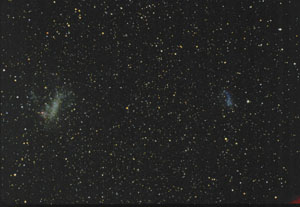
The mass of our galaxy (the Milky Way) can be computed from the dynamics of its rotation and of the motion of its satellites. It can also be evaluated by adding up its visible components, primarily stars. That these two estimates disagree by a factor of 5-10 constitutes the problem of galactic dark matter.
Either the Newtonian/Einsteinian laws of dynamics are wrong at the galactic scale, or there exists some form of galactic matter that does not emit or absorb enough electromagnetic radiation to be directly “visible”. Studies of many other spiral galaxies confirm that this problem is not unique to the Milky Way.
Originally proposed in 1986 by B Paczynski of Princeton, gravitational microlensing is a novel and indirect way to search for galactic dark matter through the deflection and magnification of the light of extragalactic stars. The search for microlensing has recently shed new light on the galactic dark matter puzzle.
Microlensing
In 1990, three groups began the search for gravitational microlensing. The main problem was the inherent large scale of such surveys. To produce a detectable magnification of the light of a distant star, an intervening compact massive object has to come closer to the star’s line of sight than one milli-arcsecond, or five nanoradians (the angle subtended on Earth by an Apollo mission lunar jeep); the tighter the alignment, the larger the magnification.
This happens so seldom that one expects less than one star in a million to be affected significantly at any given time, hence the necessity to survey some 10 million stars over many years. In contrast, variable stars are more than a thousand times as frequent and constitute a serious experimental background.
The shape of microlensing magnification is predictable and does not depend on the wavelength, contrary to most variable stars. The phenomenon is transient, because of the motion of the dark lensing object with respect to the distant star. Its duration scales as the square root of the lensing object mass, and this can be used to estimate these masses.
To simplify, one could say that two of the groups, EROS (Expérience de Recherche d’Objets Sombres – an experiment to search for dark objects) and MACHO (Massive Astronomical Compact Halo Objects), were most concerned with the dark matter problem. To probe the content of the galactic halo, they chose to monitor stars in the Magellanic Clouds – two irregular dwarf galaxies, satellites of the Milky Way, that lie close to the celestial South Pole.
The third group, OGLE (Optical Gravitational Lensing Experiment), chose to look first for microlensing where it was bound to find some – the centre of our galaxy. The microlensing rate there owing to known low-mass stars was expected to be about one in a million per year. In contrast, the rate towards the Magellanic Clouds could be anywherebetween zero, if there are no compact dark objects in the galactic halo, and about a thousand times the galactic centre rate, if the halo is swarming with lunar mass dark bodies.
The main goal of EROS and MACHO was to detect a few microlensing events caused by brown dwarfs – would-be stars not massive enough to burn via thermonuclear reactions. These objects, between a tenth and a hundredth the size of the Sun, would give rise to a microlensing rate of the order of the expected galactic centre rate.
Divergence
In September 1993 the discovery of the first microlensing candidates by the three groups aroused high hopes that the galactic dark matter problem was about to be solved. However, in the following years a gradual divergence appeared between the EROS and MACHO results. Based on two years of Large Magellanic Cloud (LMC) CCD camera images, the MACHO group presented its result as pointing to a galactic halo half-full of 0.5 ± 0.2 solar mass objects, and compatible with being totally comprised of such objects.
In contrast the EROS group observed such a small number of candidate microlensing events that it published only upper limits, first based on a photographic plate LMC survey (1990-4), and then on a survey, started in 1996, of the Small Magellanic Cloud (SMC), which uses two large CCD cameras. The EROS limits excluded, in particular, a halo full of 0.5 solar mass objects.
Despite these somewhat inconsistent results, agreement was reached on one important point: because all microlensing candidates observed by MACHO and EROS lasted longer than a month, the halo could contain no more than 10-20% of dark objects in the wide mass range between the mass of planet Mercury and one-tenth that of the Sun, that is from 10-7 to 0.1 solar masses. This excluded brown dwarfs – the dark matter candidate that had been the main motivation for this search (figure 1).
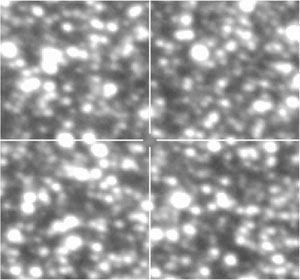
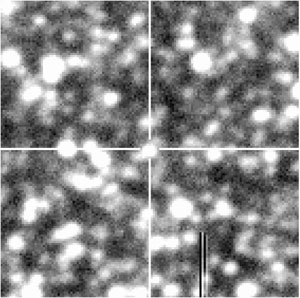
Reconciliation
Fortunately the past months have witnessed a reconciliation of the MACHO and EROS findings. The latter presented results from the first two years of an ongoing six-year survey of 17 million LMC stars that produced a meagre crop of two new microlensing candidates. Combined with their previous limits, this enables them to exclude a galactic halo fully comprised of objects of up to four solar masses – quite a respectable mass for a stellar object. (For a halo of 0.5 solar mass objects, the upper limit is now near 30%; figure 1.)
MACHO has analysed almost six years of LMC images out of seven-and-a-half years of surveying, and it has now stopped taking data. From its 13-17 observed microlensing candidates, it now favours a 20% contribution of 0.5 solar mass objects to the halo mass budget, but these are compatible with halo mass fractions ranging from 8% to 50%.
The duration of the candidates is similar, so that both results are compatible. However, the two groups interpret them differently. The MACHO collaboration favours an interpretation in terms of galactic halo objects. The distribution of stellar luminosities of its microlensing candidates agrees with that of LMC stars, which is to be expected given that the dark lensing objects do not choose the LMC star that they will lens for. The distribution of magnifications is also compatible with a random distance of the lens to the star’s line of sight.
These two tests could have revealed a possible contamination of the sample by intrinsic variable stars, but they do not shed light on the position of the dark lenses. This can be achieved by studying the spatial distribution of microlensing candidates, which should follow that of LMC stars in the case of halo lenses, or be more peaked towards the LMC centre if the lenses are low-mass LMC stars.
The MACHO group finds that the observed distribution favours halo lenses, but that it cannot completely exclude LMC lenses. The two options are, of course, very different in terms of the galactic dark matter composition.
With three to four microlensing candidates towards the Magellanic Clouds over eight years, EROS has a harder time comparing measured and expected distributions. However, it makes the following observations: compared with MACHO, EROS has chosen to monitor less frequently more stars, spread over a three times wider solid angle. Thus the smaller EROS lensing rate could be interpreted as a spatial dependence of the event rate, favouring the LMC-lens hypothesis. Moreover, while MACHO seems rather confident that its sample is background free, no such claim is heard from EROS.
Small Magellanic Cloud
Finally, there is the question of the SMC, where one candidate was seen by both groups in 1997. This event is longer than those of all EROS or MACHO LMC candidates, which does not favour its interpretation as a halo lens: as the Magellanic Clouds are separated by only 20° in the sky and are at comparabledistances from us, one would expect the characteristics of (halo) microlensing events towards both clouds to be very similar.
More quantitatively, the probability of this event being compatible with the LMC event durations is only 3%. On the contrary, as stellar velocities in the SMC are smaller than in those the LMC, it would be natural for SMC microlensing events to last longer if the lenses belong to the Magellanic Clouds.
In addition, the SMC event lasted long enough that the Earth had time to complete three-quarters of its orbit around the Sun during the magnification. This could have led to observable microlensing deformations. Such effects are not seen in EROS and MACHO data, implying that the lens is either a low-mass SMC star or a few solar-mass halo object. In the latter case its mass would not be compatible with that deduced from lenses towards the LMC.
Thus EROS concludes that this particular lens lies in the SMC. Much is expected from the comparison of LMC and SMC events but, because there are only a fifth the number of stars in the latter, no definitive conclusion can yet be reached. Nevertheless, EROS expects to be able to make a statement with an analysis of four years of data. The MACHO analysis of SMC images is also eagerly awaited.
If the MACHO interpretation is correct and there are plenty of half a solar mass objects in the galactic halo, the next challenge is to find out what they are. They cannot be ordinary stars, because these would be bright enough to be visible. One exotic scenario is primordial black holes made in the early universe at the time of the quark-hadron transition. Old white dwarf stars are another possibility: there are counter-arguments to their abundant presence in the halo, but they have the advantage that they could be detected by looking for nearby, dim high-velocity objects. Some groups are conducting such searches, including EROS. One group, led by R Ibata (Max Planck, Heidelberg), has claimed the detection of a few halo white dwarfs, but their interpretation as halo objects is unconfirmed.
Valuable results
Whatever the future developments involving galactic dark matter, microlensing surveys have already provided concrete results. The lensing probability towards the centre of the galaxy was found by the OGLE and MACHO groups to be three times as large as expected, so that microlensing can teach us much about galactic structure.
The surveys have also yielded many variable stars. This has allowed, for example, studies with unprecedented statistics of Magellanic Cloud Cepheids, a pivotal cosmic yardstick, as well as the discovery of new types of variable stars.
The monitoring of long microlensing events of bright stars provides a novel way to look for planets around the lenses
Finally, the monitoring of long microlensing events of bright stars provides a novel way to look for planets around the lenses. Compared with the current, highly successful searches that use precise measurements of stellar radial velocities, microlensing should be sensitive to lower-mass planets orbiting more distant and more typical stars.
There is a good chance that, after reconciling their results, EROS and MACHO will soon agree. A conclusion that can already be drawn is that the largest part of galactic dark matter does not comprise of dark astronomical objects lighter than a few solar masses.
As far as microlensing is concerned, the search should now be extended to longer events corresponding to heavier lensing objects. In parallel, the groups looking for other dark matter candidates, such as Weakly Interacting Massive Particles, with underground or underwater detectors or at large particle accelerators, will certainly be encouraged by the recent microlensing results.








